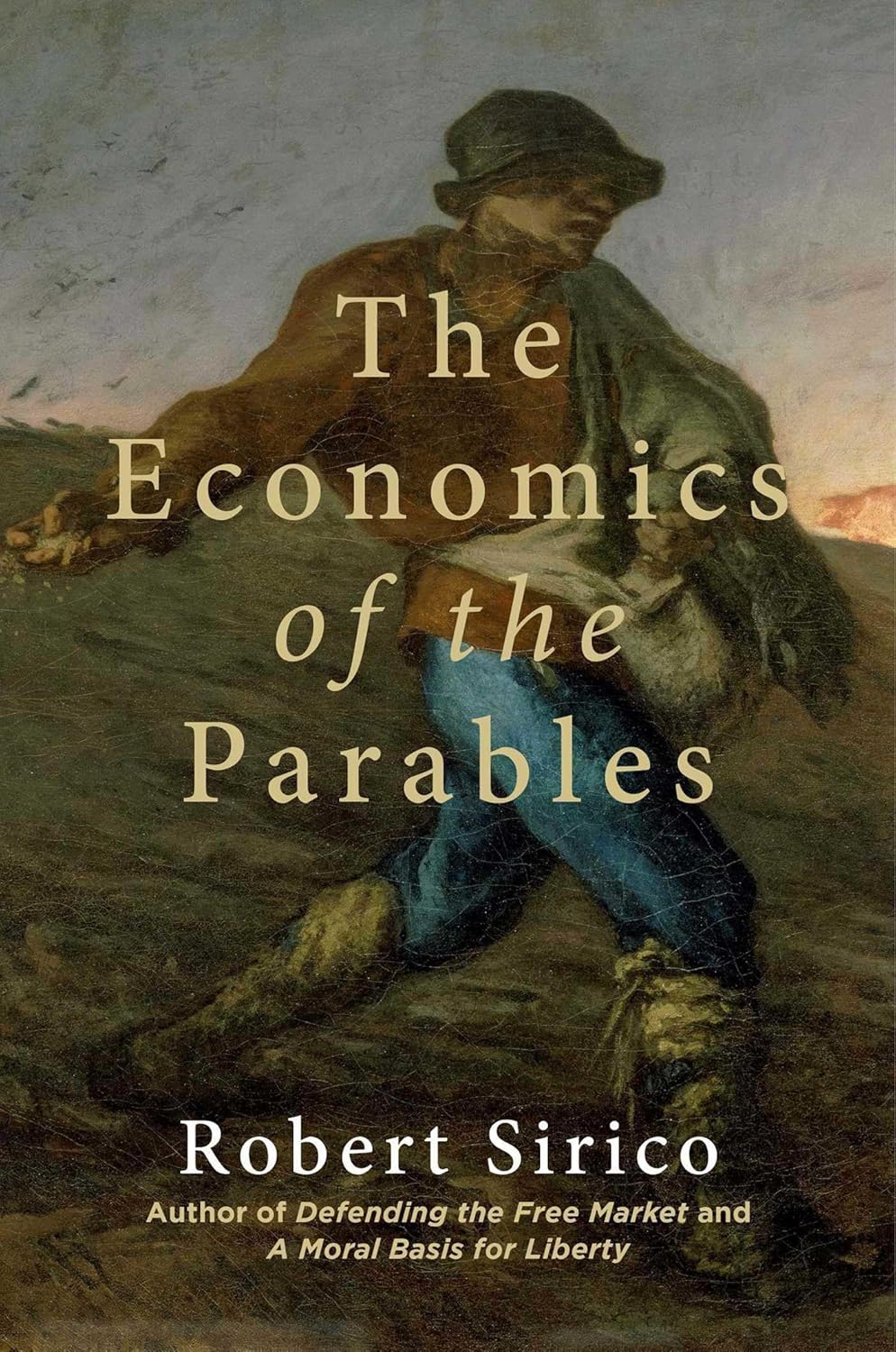
Robert Sirico is one of the leading lights in the Acton Institute for the Study of Religion and Liberty, a research organisation that promotes the benefits of free enterprise to the churches and more generally. Fr Robert is also a Roman Catholic priest, and so he also brings that ministry to bear in this book. In his Introduction he sets out his stated aim: to shed light on the economic and commercial setting of many of Jesus’s parables, as recorded in the New Testament. As he says: ‘my effort is … to detect the universal economic assumptions at play within the stories themselves, while at the same time acknowledging that these assumptions are not themselves the core intent, moral, or goal of the parable, and that, from time to time, Jesus turns such assumptions on their head to make his point.’ (page xvii). He recapitulates this point in his final section, which contains some broader thoughts on economics and the New Testament: ‘The primary focus of this book is on parables that exemplify these connections’ (page 148). As such, the author is not attempting to use the parables as the basis for instruction about economic policy or business practice. Rather, his intention is one of enriching our experience as we engage with them.
The heart of the book contains thirteen chapters, which in turn focus on a different parable – sometimes a group of related parables. These are: The Hidden Treasure (Matthew 13.44); The Pearl of Great Price (Matthew 13.45-46); The Sower (Matthew 13.3-9); The Labourers in the Vineyard (Matthew 20.1-16); The Rich Fool (Luke 12.13-21); The Two Debtors (Luke 7.37-50); The Talents (Matthew 25.14-30); The King Going to War (Luke 14.28-33); The House Built on a Rock (Luke 6.47-49); three parables which serve to give ‘Lessons in Stewardship’ (Luke 12.42-48, Matthew 24.45-51, Luke 16.1-13); The Good Samaritan (Luke 10.30-37); The Rich Man and Lazarus (Luke 16.19-31); The Prodigal Son (Luke 15.11-32). Every parable is printed out in full, in the traditional King James Version.
I felt that Sirico brought a preacher’s skills to bear very successfully in every case; he set me wondering about things, and thinking about how Jesus’s words might apply in my own life. For example, when considering the Parable of the Pearl of Great Price, he makes the obvious but interesting comment about pearls, that: ‘In the ancient world, they could not be manufactured; they had to be discovered’ (page 13). Another thought-provoking comment for me, in the Parable of the Labourers in the Vineyard, was the observation that: ‘in order to be practically generous – the virtue so abundantly displayed by the landowner in this parable – it is first necessary to have an abundant harvest, to create superfluous wealth…’ (page 37). When considering the Parable of the Two Debtors, Sirico includes a very interesting discussion about the idea of the ‘cost’ of mercy – ‘a notable act of charity, redolent with beauty, instructiveness, and inspiration’ (page 56). I was also surprised to realise that I’d never properly noticed that the Parable of the Prodigal Son follows two other ‘lost and found’ parables, a reminder for which I am very grateful (page 139).
On occasion, the author introduces a common preacher’s technique, that of re-telling the parable in a different and usually more contemporary way. For example, in the Lessons from Stewardship chapter, Sirico describes a ‘parable’ involving a CEO and their staff (the ‘stewards’), and the stockholders (the ‘owners’) (pages 103-104). He also suggests an analogy involving cars when considering the Parable of the Hidden Treasure (pages 3-4). However, his main intention is something more foundational, which is to provide more information to the reader about how economics works, so that a deeper appreciation of the parable in question can be had. This is a similar project to that of an historian or geographer, each able to give extra details about the context of a piece of teaching or writing. Economics as a subject is, at its best, interwoven with other disciplines such as history and geography, and Sirico’s project is in that sense admirable. He has helpful things to say about how markets operate, and the way in which contracts play an important part in this. However, there were occasional moments when I wanted to challenge some of his suggestions, for example when he equates a ‘negotiator’ with an ‘entrepreneur’ (page 15). It seems to me that the arbitrage function in markets is somewhat different to the way in which enterprise brings new possibilities about, and creates new markets; and indeed Sirico does hint at this as well, when at one point he brackets entrepreneurs with artists (page 27).
It is worth noting that, while extra technical contextual information about any subject can be very important, especially for those who like data and facts, there are other ways of approaching the Scriptures. For example, using the Lectio Divina method when reading a parable can be very rewarding for some, with its openness to a more sensory and imaginative approach. The ‘context’ then becomes the life of the person who approaches the parable, but it is still true that their own experience of life in an economy (working, buying, selling, owning) will be significant. In that vein, it is clearly important to the author that Jesus chooses so many ‘economic’ subjects for his parables; this reflects the fact that we are all economic agents, whether we realise it or not. To be alive as a human being is to be a player in countless markets.
Sirico does not aim to collect together and incorporate the wide variety of interpretations which scholars and preachers have applied to the parables. Of course, this is not a failing of the book, which has a different purpose. However, there were one or two moments when I felt that a particular interpretation could have been mentioned. For example, Augustine’s interpretation of the Parable of the Good Samaritan sees the wounded man as Adam and the Samaritan as Christ; and another interpretation asks us to see God as the one who takes the risk of travelling the dangerous road to be with us. I also felt that the grouping of the Parable of the Unjust Steward with the very different ‘Faithful Steward’ parables in chapter ten was perhaps a mistake. The ‘Unjust Steward’ parable is one of the most challenging, but the interpretation offered by Sam Wells in his 2019 book, A Future That’s Bigger than the Past, is very rich indeed; it was inspired by a lecture Wells heard Ched Myers give in 2006. I also noted that, in the Parable of the Talents, Sirico ignored Matthew 25.29: ‘For unto every one that hath shall be given, and he shall have abundance: but from him that hath not shall be taken away even that which he hath.’ I have always felt that this is the exegetical key to the entire parable, but Sirico, like most commentators, implicitly brackets it as an irrelevant aside. Instead, he speculates about what would have happened if the third (lazy) servant had been entrepreneurial but lost his master’s money; ‘It is hard to imagine … that he would have been treated so harshly’ (p.73). Here, my own understanding of the very purpose of this parable does vary from that of the author.
Sirico strays from the stated purpose of his book in one particular manner quite often. He re-states this claimed purpose as he introduces the final parable, that of the Prodigal Son: ‘In our study of Jesus’ parables we have sought to fill in the gaps related to their economic presuppositions and ramifications rather than attempting to offer a comprehensive analysis of the parables in all their amazing and intriguing detail’ (page 134). However, the author frequently introduces his own implicit interpretation by pushing back against Christians and Church leaders who are wary of market economics, and against economic policies that damage the free operation of markets. Examples of Sirico in this mode include: ‘All too many thoughtful Christians see this fact of people coming together to share and exchange values for mutual benefit as morally suspicious’ (page 10). ‘Policies that encourage short-sightedness, such as high taxes, immobilizing regulations, and credit expansion are to be avoided because they confuse and obscure market signals necessary to discern the proper conditions for investment’ (page 87). This is despite his stated desire, in this book at least, to eschew a temptation to read back into the Scriptures the moral basis for market-based economics (page 43). For some readers, I felt this extra strand of interpretative comment might be annoying, although for others it will be helpful. Sirico adds a final chapter which magnifies this interpretative theme, and which draws upon his 2012 book, Defending the Free Market: The Moral Case for a Free Economy.
Each chapter of this book has a picture, for example William Hogarth’s rendition of ‘The Good Samaritan’ (page 112) and Johann Eck’s ‘The Sower’ (page 22). These are mostly quite historical in feel, although there is a slightly more contemporary ‘He Built on the Sand’ image (page 92). I wondered how it would have changed the feel of the book if these images had been more deliberately current and perhaps culturally varied. After all, economics is a theme that permeates every human society in the world. I did also notice that the Parable of the Talents was wrongly ascribed to Matthew 15 rather than chapter 25 (page 64). Not-withstanding these minor quibbles, I found the aim of this book to be very worthwhile, and its execution to be skilfully done.
‘The Economics of the Parables’ by Robert Sirico was published in 2022 by The Acton Institute / Regnery Gateway (ISBN: 978-1-68451-242-3). 204pp.

Edward Carter is Vicar of St Peter Mancroft Church in Norwich, having previously been the Canon Theologian at Chelmsford Cathedral, a parish priest in Oxfordshire, a Minor Canon at St George’s Windsor and a curate in Norwich. Prior to ordination he worked for small companies and ran his own business.
He is a former Chair of the Church Investors Group, an ecumenical body that represents over £10bn of church money, and which engages with a wide range of publicly listed companies on ethical issues. His research interests include the theology of enterprise and of competition, and his hobbies include board-games, ‘acrylic resin’ art, and film-making. He is married to Sarah and they have two adult sons.